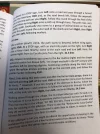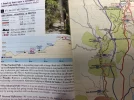The biggest changes on the Ingles route are as follows:
Ferrol / Neda to Pontedeume section - at Vilar do Colo, the new route goes off right after passing under the motorway, and goes through the countryside till it comes to Cabanas and then comes down a very steep hill to the river estuary where you walk over the bridge to Pontedeume. The old route went off right before the motorway junction and came down onto the beach at Cabanas which you walked the full length of before you come to the Pontedeume bridge. I walked the old route, due to an absence of markers and a friendly local directing where the old route was. I think the old route was better.
Betanzos to Hospital de Bruma - two main changes. The first at Cos, you turn left and walk along a pavement on a road and follow this for about 2km down to Presedo. The old route somehow walked through fields to the north of the road. the new route was not signposted well with waymarks and you needed to trust that walking along the road was the correct way. For the last 1km, the pavement stops and you do need to walk along the actual side of the road, down a hill and round some bends where there path then branches off left to Presedo. Walking on the road was not too pleasant, but there was not too much traffic to both
Later, at Leiro, the new route branches off and misses out the fearsome hill up to Hospital de Bruma and Bar Julia. Most of the walk is unpaved forest road with a long gradual incline. You keep wondering where the fearsome hill is, but it never comes. At the top, you join a fairly large raod where the Ingles from La Coruna joins and you need to walk on the side of the road (pavement half and half) for about 2km, including passing a quite large electricity substation. This is where Bar Avelina is, which was not too welcoming.
Hospital de Bruma to Sigueiro - when you pass over the motorway, the new Ingles route takes you right and down onto the motorway embankment. What you do not realise at that point is that you walk alongside the motorway for a good 4km, albeit separated from the motorway by a metal fence. But walking alongside a motorway for over 45 minutes is so depressing, seeing cars do what you are doing in an hour, in a matter of minutes. The road is also noisy. If you can, do not turn right, but carry on the road and then take the second road on the right. You then walk along a country road (no pavement, but you can see and hear the occasional car that comes) all the way to Sigueiro. This is the one time when walking on tarmac beats walking on a grass path.
Sigueiro to Santiago - the new route, for the better, takes the Ingles off the main Sigueiro to Santiago road and onto country roads which run parallel about half a kilometre away. You need to be on the right hand side of the main road in Sigueiro as you walk over the river.
On guides, if you look a the CSJ guide, it is so detailed, in terms of exactly where to turn right, left or go straight on. Invaluable if you are lost, but if you have it open when you walk, you will be worrying when the next turn comes and literally walking with your nose in the book, instead of watching and enjoying the camino. Also, your judgement of what is 100, 200 or 400 metres (for when you need next to turn left, reading the guidebook), invariably turns out to be half of what it is in reality, especially when you are tired, meaning that if you are actively walking with the guidebook, you are stressed half the time that you have missed where to go.
You needn't be. The Ingles, generally, is well marked by the triangular waymarks, which appear, as and when there is a junction, fork or a place you should change direction (or carry on straight when other roads / tracks appear left and right. I think having a guide is good, but I would carry it in your pocket, for reference when things are confusing, not to get you along the way. The waymarks do that. Unfortunately, unlike more popular caminos, there is not the pilgrim traffic to look ahead and follow. I saw no more than 10 other pilgrims per day, and therefore, a guidebook is handy to have, when you are confused.

























